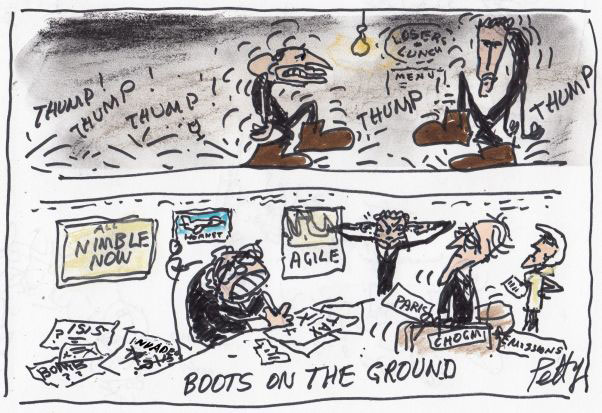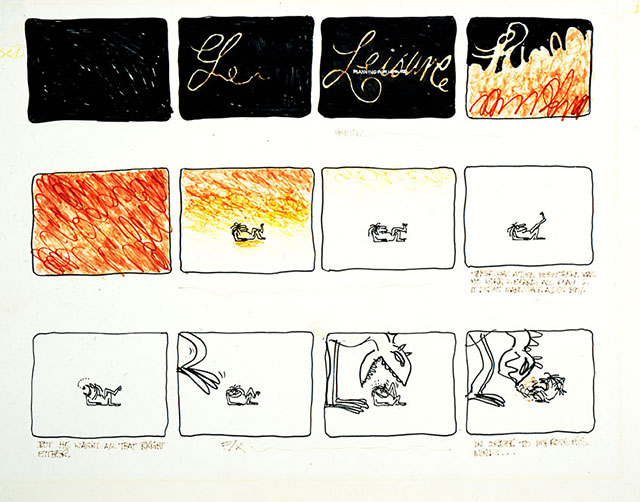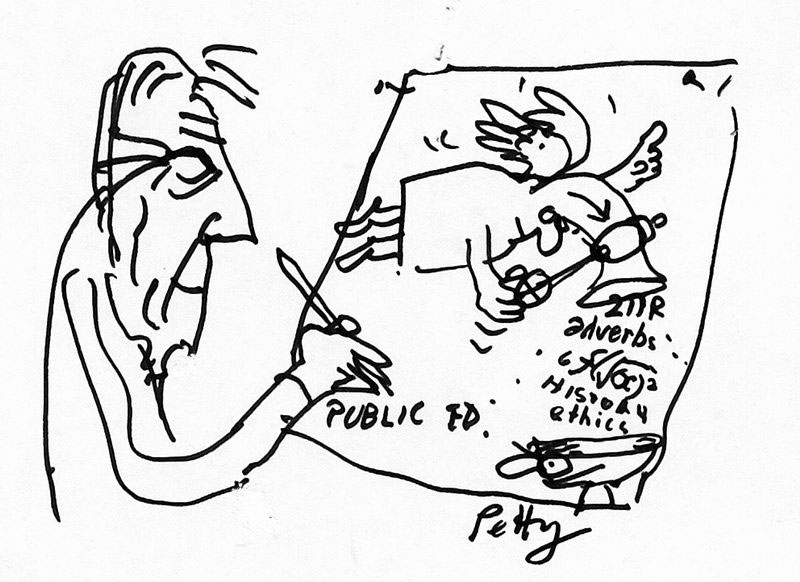Cartoon by Bruce Petty, mid-2010s. The big-eared, -nosed and -lipped politician in the first panel is Australian Prime Minister Tony Abbott.
Bruce Petty was an Australian political cartoonist, sculptor and animated film director. Between 1976 and his death in 2023, he was the house cartoonist of the newspaper The Age. He gained a reputation as a sharp cartoonist, working in a loose, scribbly style. As an animator, he is best known for the short 'Leisure' (1976), which became the first Australian animated cartoon to win an Academy Award. Petty also directed the satirical mockumentary 'Global Haywire' (2006).
Early life and career
Bruce J. Petty was born in 1929 in Doncaster, a suburb of the Australian capital Melbourne. His father owned an orchard, where Petty helped out from an early age. Petty inherited a love for machinery, since his dad often made technical devices to make work in the orchard easier. The boy also loved to draw. His interest in animation was sparked by a 16mm short of Pat Sullivan and Otto Messmer's 'Felix the Cat', which his father screened for his children. Petty's main graphic influences were Felix Topolsky, Saul Steinberg and James Thurber. Originally, Petty felt limited by his graphic skills, particularly regarding anatomy. But once he saw the work of these three cartoonists, he noticed that their lack of virtuosity didn't stand in the way of brilliant ideas and, more importantly, making a successful career out of it. It convinced him that he too could make a living as a cartoonist.
'The Way of the Life Raft' (1959).
Petty started out doing book decoration for Colourgravure, while taking evening art classes at RMIT University. In 1949, he learned that the Owen Brothers animation studio in Box Hill looked for someone to do fill-ins for shorts and advertisements. He applied for the job and soon worked on their educational cartoon 'Careful Koala', for which he also provided the script. Although he felt the film was "terrible", it left him with various useful skills. The Owen Brothers also had a commercial art studio in Melbourne, where Petty enhanced his knowledge of the medium. One time he devised a Bolex camera with a single frame hanging over a glass plate, lit from underneath, because if it was lightened from the top, the heat would make pens dry up more quickly. These innovative solutions saved him a lot of time during the animation process.
While working in the commercial art studio in Melbourne, Bruce Petty heard that many of his colleagues went to London. In 1954, he too crossed the globe and settled in the United Kingdom for seven years. He made a living in theater design, while publishing his cartoons in various magazines. By 1961, he moved back to Melbourne. Petty was married three times. His first wife was Julie Crigg, famous as a journalist and film critic for ABC. Petty remarried with novelist Kate Grenville, best known for her book 'The Secret River' (2006), before eventually settling with bookseller Lesley McKay.
'The Anzac March' (26 April 1969).
Cartooning career
Petty's earliest cartoons were published in the Australian paper The Herald. When Petty moved to the United Kingdom in 1954, he livened up pages in Esquire, Punch, The Saturday Evening Post and The New Yorker. His work from the late 1950s and early 1960s still consisted of basic, apolitical humorous cartoons. By the time Petty moved back to Australia, his drawings could be enjoyed in The Bulletin and Australian Women's Weekly. He became the house political cartoonist for Sydney's The Daily Mirror and, starting in 1965, a resident cartoonist for The Australian. At the time, Petty wasn't very good at caricaturing. He recalled that French president Charles de Gaulle was the only politician he could draw recognizably enough. Since most Australian newspapers at the time barely printed editorial cartoons, it was also difficult to find a job in this profession. The Melbourne newspaper The Age, for instance, mostly featured written articles and photographs. Still, by 1976, Petty became the house cartoonist for The Age, where he would publish on a weekly basis for the next four decades.
Petty worked in a scribbly style and mainly focused on political and economic news. One time, his cartoons caused controversy. In 1967 the Australian government was stuck in the VIP Aircraft affair, where Prime Minister Harold Holt was accused of having misled parliament about the use of VIP Aircraft by the Royal Australian Air Force. Petty drew a large fan on top of the Australian Defense headquarters, bombarded by excrement, a pun on the expression "when shit hits the fan". Many readers felt offended and disgusted by the image.
Petty's Australia Fair: Sydney (1967).
Petty's first cartoon compilation was published under the title 'Australian Artist in South East Asia' (Grayflower Publications, Melbourne, 1962). Celebrated cartoonist Ronald Searle wrote the foreword. The book features various sketches Petty made during his travels in South East Asia. 'Petty's Australia Fair' (Cheshire, Melbourne, Canberra, 1967) is a witty satirical commentary on suburban development in his home country. Each chapter is devoted to a major Australian city or province, which Petty visualizes in richly detailed illustrations. Petty mocks the modernization of Australia, destroying all authentic and picturesque landscapes in favor of characterless and often tacky new buildings, which ironically praise the country's past by "striving for yesterday".
Other compilations of his political cartoons can be found in 'The Best of Petty' (Horwitz Publications, London, 1968), 'A Portfolio of Petty' (Ibis, Sydney, 1969), 'The Penguin Petty' (Penguin Australia, 1972), 'Petty's Australia: And How It Works' (Penguin, 1976), 'The Petty Age' (Wild & Woolley, 1978), 'Petty's Money Book' (Collins, Sydney, 1983), 'Women and Men' (Allen & Unwin, Sydney, 1986), 'Bruce Petty's The Absurd Machine' (Penguin, 1997). A fine overview of Petty's entire graphic career is 'Petty's Parallel Words' (High Horse Publishing, 2008), which, apart from his best cartoons, also includes sketches and etchings.
Cartoon by Bruce Petty, 2014, depicting Australian Prime Minister Tony Abbott.
Film career
Over the decades, Bruce Petty, wrote, directed and produced several short films. 'Australian History' (1971) is an educational brief overview on the history of his home country, made in collaboration with the Experimental Film and Television Fund. 'A Big Hand For Everyone' (1971) is an animated short contrasting the optimism of the average citizen with the pessimism of the academic expert about the future. The short won the Golden Reel Award (1971). After the TV comedy film 'The Money Game' (1972), Petty worked on 'The Magic Arts' (1978), a documentary short produced by Film Australia for the Australia Council for the Arts. With 'The Movers' (1986), Petty made a more straightforward humorous film, starring a couple traveling back in time, all without ever leaving their comfy chair. 'The Mad Century' (2000) also reflected on the past, more specifically the 20th century. With 'Human Contraptions' (2003), Petty made ten short films commenting on the evolution of various institutions, such as law, education, finance and art. 'Utopia' (2012) is a documentary on our concepts of the future, which often delve into naïve predictions. Petty's cartoons about Aboriginal culture were featured in Robert Bropho and Jan Roberts' documentary 'Munda Nyuringu: A Film on the Fringedwellers of the Goldfields' (1984), a look on Australia's history from the perspective of native Australians. He was also interviewed for the documentary 'Senses of Cinema' (2022), about the history of alternative filmmaking in Sydney and Melbourne during the 1960s and 1970s.
Storyboard for 'Leisure'.
Leisure
Petty's best-known and most awarded films were 'Leisure' (1976) and 'Global Haywire' (2007). 'Leisure' is an animated short about relaxing, hobbies and other pastimes throughout the centuries. The film has a satirical twist, where all of mankind's attempts to find leisure time eventually culminate in tightly scheduled "free time" in between hard labor. In other words: lack of spontaneous relaxation makes modern-day leisure barely distinguishable from boring and tedious jobs. 'Leisure' received the Grand Prix (1976) at the Melbourne International Film Festival and became the first Australian animated short to win the Academy Award for "Best Animated Short". However, the prestigious little statue went to the film's producer, Suzanne Baker, which incidentally also made her the first Australian woman to win an Academy Award. Since neither Petty, nor Baker, expected their film to win and lacked the budget to travel all the way to California, they didn't attend the ceremony. The category's host, comedian Marty Feldman, therefore accepted the Oscar on their behalf.
Global Haywire
In 2007, Petty made the satirical mockumentary, 'Global Haywire', in which an international committee tries to unravel why our world is polluted with war, poverty, terrorism, religious fanatics, energy crises and other atrocities. Narrated by Tom Baker (most famous as the fourth actor to play Dr. Who), the film is intercut with Petty's own cartoons, archive footage and interviews with Noam Chomsky, Gore Vidal, Robert Fisk, Tariq Ali and journalist George Monbiot. The committee eventually traces the culprit for all of life's troubles: a man named Vince who owns a flying machine. Rich people are seated at the top, while poor people suffer below. The film won "Best Documentary Director" and "Best Documentary Sound" during the Australian Film Institute Awards.
Sculpting
Bruce Petty was also active as a sculptor. His 'Man Environment Machine' was presented at the Australian Pavilion during the 1985 World Expo in Tsukuba, Japan. Petty's love for complicated machinery is also visible in his cartoons, which led to comparisons with similar cartoonists like William Heath Robinson and Rube Goldberg.
Recognition
In 2001, Bruce Petty received the Silver Stanley Award from the Australian Cartooning Association, followed by a Quill Lifetime Achievement Award for Excellence in Victorian Journalism (2009) and a Walkley Award for Most Outstanding Contribution to Journalism (2016). A cartoon about the Asian economic crisis won him the Political Satire Prize (1998) on behalf of the National Museum of Australia.
Death and legacy
Bruce Petty died in 2023, at age 93. He was an influence on Michael Atchinson, Martin Brown and Bill Leak.
Self-portrait.









